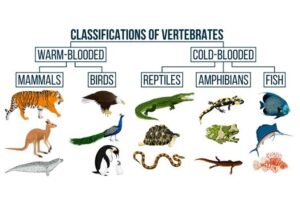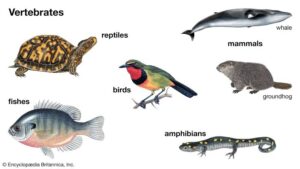Back to: ZOOLOGY 100 Level
Welcome back! Today, we’re going to explore the amazing world of vertebrates. Vertebrates are animals with a backbone, and they are classified into different groups based on their unique features. Understanding how vertebrates are classified helps us learn more about how diverse and fascinating the animal kingdom is. Let’s jump right in!
Classification of vertebrates

What Are Vertebrates?
Vertebrates are animals that have a backbone or vertebral column made of bone or cartilage. This group includes a wide range of animals, from the smallest fish to the largest mammals like whales. Vertebrates are part of the phylum Chordata, which also includes animals like fish, amphibians, reptiles, birds, and mammals. All vertebrates share a key feature—the backbone, which supports and protects their spinal cord, an important part of their nervous system.
The Five Main Groups of Vertebrates
Vertebrates are classified into five main groups based on their characteristics, such as how they reproduce, their body structure, and how they breathe and move. Let’s look at each group in detail:

- Fish (Pisces)
Fish are the oldest group of vertebrates and are found in aquatic environments like oceans, rivers, and lakes. They are adapted to living in water, and they breathe using gills. Most fish have scales covering their bodies and fins to help them swim. There are two main types of fish:- Bony Fish: These have a skeleton made of bone. Examples include tilapia and salmon.
- Cartilaginous Fish: These have a skeleton made of cartilage instead of bone. Examples include sharks and rays.
- Amphibians (Amphibia)
Amphibians are vertebrates that live both in water and on land. They start their life cycle in water, where they lay eggs that hatch into tadpoles (which have gills), and then they undergo metamorphosis to become adults with lungs. Amphibians include animals like frogs, toads, salamanders, and newts.- They have moist, smooth skin, which helps them absorb water and oxygen.
- They rely on water for breeding, as their eggs do not have a protective shell.
- Reptiles (Reptilia)
Reptiles are vertebrates that are well adapted to living on land. They have dry, scaly skin that helps prevent water loss, and they lay eggs with leathery shells, allowing them to reproduce away from water. Examples of reptiles include lizards, snakes, turtles, and crocodiles.- Reptiles are cold-blooded, meaning their body temperature changes with the temperature of their surroundings.
- Most reptiles breathe using lungs and can live in very dry environments.
- Birds (Aves)
Birds are vertebrates that are specially adapted for flying, although some species have lost the ability to fly. Birds have feathers, wings, and hollow bones that make them lightweight. They lay hard-shelled eggs and are warm-blooded, meaning they can maintain a constant body temperature. Examples include eagles, sparrows, and penguins.- Birds breathe using lungs and have a high metabolic rate to support the energy demands of flight.
- Mammals (Mammalia)
Mammals are vertebrates that are characterised by having hair or fur on their bodies and mammary glands, which produce milk to feed their young. Mammals are warm-blooded and breathe using lungs. They give birth to live young (except for monotremes like platypus, which lay eggs). Examples of mammals include humans, lions, elephants, and whales.- Mammals are diverse, with species adapted to living onland, in the air, or in water.

Summary
- Vertebrates are animals that have a backbone and are classified into five main groups: fish, amphibians, reptiles, birds, and mammals.
- Each group has unique features that help them survive in their environments, such as scales, feathers, fur, and the ability to breathe in different ways.
- Vertebrates are incredibly diverse, and understanding their classification helps us appreciate how each group plays a role in the animal kingdom.
Evaluation
- What are the main characteristics of vertebrates?
- How do amphibians differ from reptiles in terms of their life cycle?
- Name one animal from each vertebrate group and explain its special adaptation.
- Why are mammals considered warm-blooded, and how does that benefit them?
You’ve just learned about the five main groups of vertebrates and the unique characteristics that define each one. It’s amazing how diverse life is on Earth, and you now have a clearer understanding of where each group fits into the bigger picture. Keep up the great work, and I’m excited to see what we’ll learn next!
